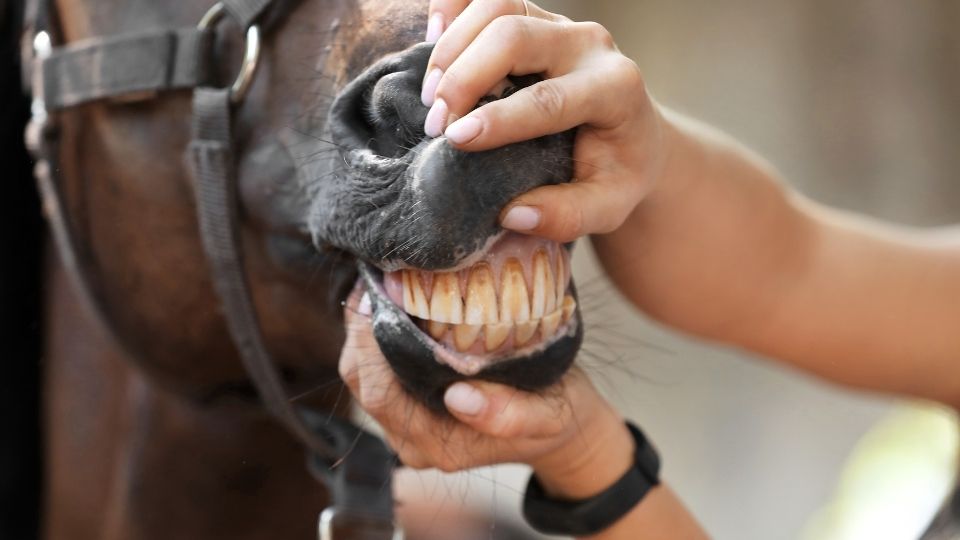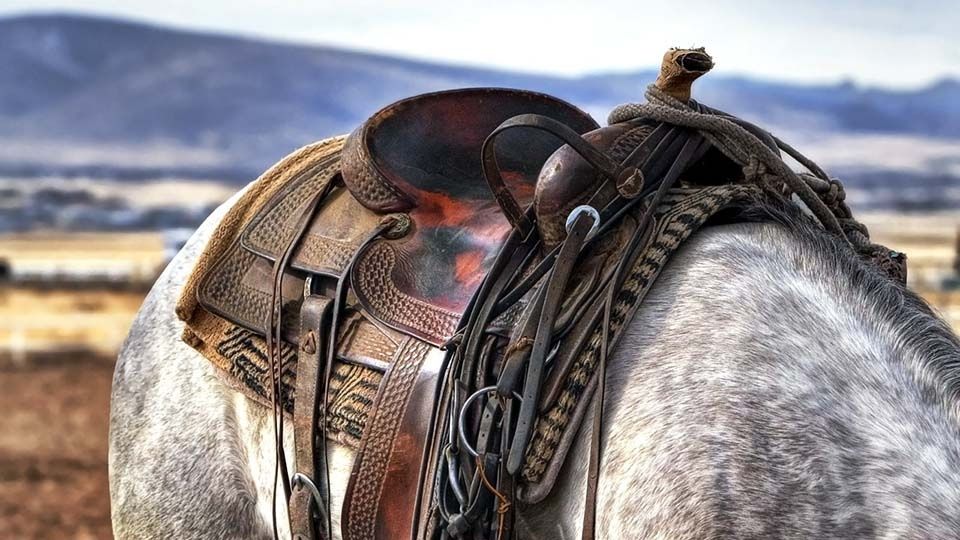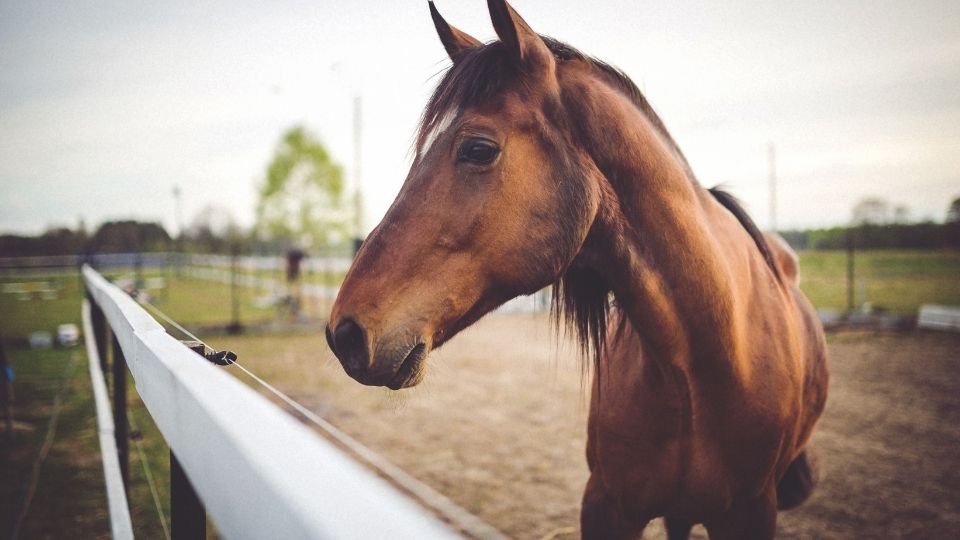Equine Nutrition: Forages
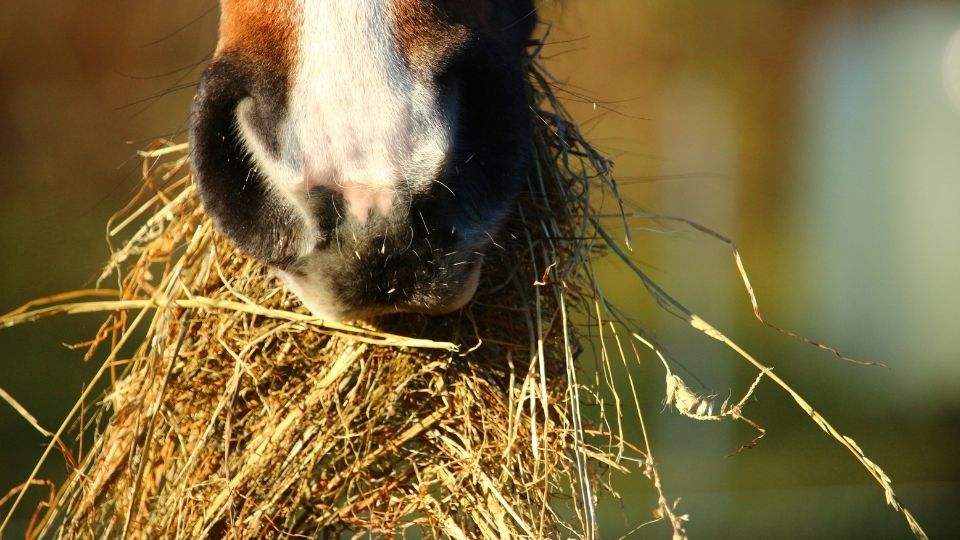
There are two major kinds of forages (hay) used for feeding horses. These include grasses and legumes.
Hays or Cured Feeds
Grasses (orchard, timothy, brome types) tend to be lower in protein and energy and somewhat safer as horse feeds, while legumes (alfalfas, clover, etc.) are usually higher in protein and energy and can potentially cause more digestive and health problems, especially if sufficient water is not available to help rid the horse’s body of excess nitrates through urination. Recent tests of alfalfa hay in horse feeding schemes have proven no adverse affects as long as sufficient water was available in the diet. However, as a general rule, the preferred feed for particularly idle or light work horses is grass hay and/or grass/alfalfa mixed hays rather than straight alfalfa. One must also recognize the potential calcium-phosphorous imbalance that may occur when feeding straight alfalfa without the appropriate salt/mineral mix to help balance the higher percent of calcium in relation to percent phosphorous. This ratio can be as high as 5 or 6 parts calcium to 1 part phosphorous. While older horses can tolerate high levels of calcium, growing horses cannot tolerate greater than 3 parts calcium to 1 part phosphorous without possible developmental problems (Evans, 1981, p. 176).
It is essential no matter whether you choose to feed grass hay, alfalfa hay or some mixture, that the hay be bright, clean and fresh, free of dust and mold and/or other contaminants. Ideally testing for nutritional values (nutritional content) will provide a more exact indication of hay quality and provide the buyer with helpful information. The following section on digestion will help horse owners understand the importance of feeding quality forages to insure proper feeding and care of their horses.
The Digestive Tract
Where does digestion of hay or pasture take place in the horse’s digestive tract?
The horse differs from cattle in that forage digestion takes place in the hind gut vs. the stomach compartments in cattle. The hay passes through the esophagus, stomach and small intestine before reaching the cecum. The cecum has bacteria, fungi and protozoa that work to break down the fibrous material. The fiber is broken down into Volatile Fatty Acids used for energy, but as a lower quality energy than that absorbed by the small intestine. Forages keep the bacteria healthy and happy which helps maintain gut motility.
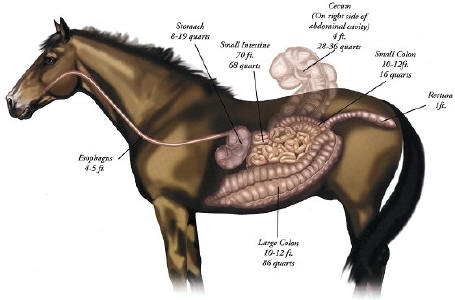
Can this digestive system setup cause problems in digestion?
Yes. In cattle mold is broken down and rendered nontoxic as it first enters the digestive tract in the four stomach compartments. While in horses the hay will pass through the stomach and small intestine before being broken down by bacteria in the cecum. As toxins pass through the small intestine, the site of major nutrient absorption, digestive upset and a potential colic episode may result.
Also, with the design of the digestive tract it is good practice to feed hay first, then any grain portion of the diet. This will allow for normal passage of the grain whereas if the grain is fed first, the hay traveling at a faster rate through the stomach and small intestine can push the grain through faster than it should. The cecum is designed to handle forage or insoluble carbohydrates. If the grain, soluble carbohydrates, is pushed through the tract to the cecum it can cause founder or colic through death of the bacteria due to a lowering of the pH in the cecum.
Pastures
Realizing that pastures in the Intermountain Area are only a seasonal feeding option and that pastures are higher in percent moisture, other considerations need to be made in utilizing pasture as a horse feed. A horse must graze longer to consume the required amount of total dry matter intake as compared to feeding baled hay at the manger. However, it is not essential nor suggested that a horse graze out all day and night especially on lush, high quality irrigated pastures. In this case, horses will tend to over eat and become more obese than is desirable for their health and performance ability. Preferred techniques in grazing systems include some dry lot time during part of the day and/or evening, in order to control over eating. Many aspects will influence how much grazing time a horse will need to meet its daily minimum nutritional requirements such as quality of the forage, moisture content of the forage, along with work load of the horse. A range of grazing time could be as long as 6 – 10 hours per day for a horse at maintenance. Young, growing horses may need as much as 15 hours a day to meet their developmental needs. Most horses on lower quality or lower producing pastures will need to be supplemented with a daily hay source.
No matter what your feeding choice, be sure that transitioning from pasture to dry feed or visa versa, changing from one crop to another (first to second crop), or from grass hay to alfalfa hay (or visa versa) are all done gradually to reduce the potential of digestive problems, colic or founder. Typically, any change in feed should occur over a 7 -10 day period with mixing of both the old and new forages. Initially, the old forage will make up most of what is offered to the horse, but with each day’s feedings the new forage will make up a larger percentage of the mixture until it is the sole forage.
How much forage does a horse need on a daily basis?
Typically an adult horse will consume 1.0 to 2.0 percent of its body weight daily in forage. This would mean that a 1,000 pound horse would consume 10-20 lbs. of cured/baled (90% dry matter) hay per day. A horse on pasture, consuming pasture at 20-30% dry matter (70-80% moisture) would require significantly more intake, approximately 30-60 lbs daily because of the extra moisture present in the pasture consumed each day. With hay, it is a good practice to periodically weigh a flake to be sure that you are giving adequate amounts of forage. A horse in light work or at maintenance can do well on good quality forage only, depending on if the horse is an easy or hard keeper. A good rule of thumb is to keep the forage level at 50% or more of the diet. It is desirable to have the forage level as high as possible for good gut motility. This will not always hold true for horses in intense work that require higher levels of concentrates (grain) for energy, but it is still desirable to have as much of the diet as forage as possible. A horse that is receiving high levels of concentrates and low levels of forage is more prone to digestive upset and diarrhea.
For more information on including concentrates in your horse’s diet and equine nutrition refer to fact sheet AG/Equine/2006-01.
For more ideas on managing horse feeds, pasture grass varieties and other horse nutritional topics contact your local county USU Extension office.
References
- Evans, J. W. 1981. Horses. San Francisco: W. H. Freeman and Company.
- Lewis, L. D. 1996. Feeding and Care of the Horse (2nd Ed.). Philadelphia: LippinottWilliams and Wilkins.
- http://www.alfalfa.org/pdf/Alfalfa%20for%20Hor ses%20(low%20res).pdf
Reviewed March 2010
Utah State University Extension
Peer-reviewed fact sheet
Authors
Dr. Patricia Evans, Extension Equine Specialist; Scott McKendrick, Coordinator, Statewide Equine and Small Acreage Program
Related Research


